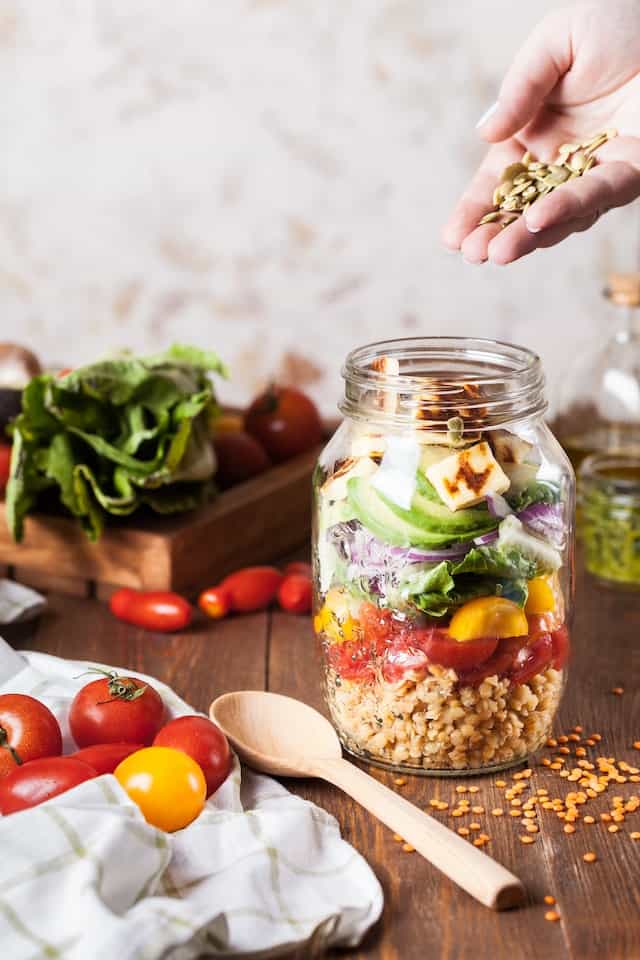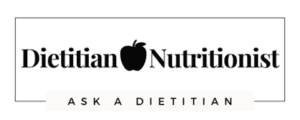With busy schedules, lunchtime can be a difficult meal to get to at all. Many people rely on fast food for lunch because coming up with and planning healthy lunch ideas might feel overwhelming. Lunches don’t have to be huge gourmet meals to be healthy- they can be super simple and easy to grab on your way out the door!
The healthiest lunch ideas in your 50’s include burrito bowls, turkey veggie wraps, whole wheat pasta salad, sweet potato and veggies, chef salad, hummus veggie pitas, quinoa salad, and homemade smoothies with waffle and nut butter.
Eating a healthy lunch might seem challenging, but it is doable! The most important thing is to eat a balance of macronutrients: carbohydrates, protein, and fat. An easy way to make sure you get a good balanced meal is to always choose a starch, protein, fruit, and a vegetable!
Read on for information about important nutrients to include in your 50’s, how to structure a healthy lunch, meal ideas, and general nutrition tips for adults!

What Nutrients Are Important in Your 50’s?
Your body works extremely hard to take care of you, all day, every day. Providing your body with the proper nutrition is important for improving energy levels, preventing disease, and decreasing your risk of illness and injury. Let’s look at the nutrients that are important as you get older!
Carbohydrates
A lot of people think that they need to cut out carbs as they get older, but carbohydrates are an essential nutrient for your body that provides you with energy! About half of your calories during the day should be coming from carbohydrate sources. It can be easy to overdo it though, so make sure you are balancing your carb intake with other nutrients too.
Protein
So much of your body is made up of protein- muscle, hair, nails, and more! Muscle mass also naturally decreases with age, so consuming adequate protein will help you maintain the muscle you have and even build more if you want to! Protein also helps keep you feeling satisfied after a meal and helps to sustain the energy from your carbohydrates.
Fat
There are different kinds of fats, and some are better for your body than others. Including more healthy fats (unsaturated fats) such as avocado, olive oil, nuts, and salmon will help to decrease inflammation in the body and keep your cholesterol levels in check. Similar to protein, fat can help you feel satisfied and sustain your energy levels.
Vitamins and Minerals
You don’t necessarily have to take a bunch of supplements to get all of your vitamins and minerals. In fact, the best way to make sure your body is getting what it needs is to get a variety of foods from each food group every day. Especially focusing on consuming plenty of fruits and vegetables will help to boost your vitamin and mineral intake and keep your body feeling great!
Water
Sometimes we don’t think about water as a nutrient but it absolutely is- and an important one too! The best way to consume water is to sip it consistently rather than chugging a bunch of it at once. This will help keep you well-hydrated throughout the day!
Fiber
While fiber is not technically a nutrient, it is an important aspect of some foods that helps to keep your digestive system regulated, keep you feeling full and satisfied when you eat, and keep your cholesterol levels in a healthy range. Whole grains, legumes, fruits, and vegetables are going to be some of your greatest sources of fiber, so make sure you are including plenty throughout your day!
How to Structure a Healthy Lunch
If your lunch doesn’t look like it came from a 5-star restaurant, that is totally okay. In fact, sometimes lunch is just a bunch of random foods that are thrown together in a rush! I encourage people to remember that eating something is better than eating nothing, so if your lunch isn’t the most perfectly balanced meal all the time, just do the best you can.
There are four things I try to include with my lunches to make sure it is balanced and nutrient-rich:
Starch
There are a wide variety of starch options to choose from. Your options might include a tortilla, bread, crackers, pretzels, rice, pasta, a bagel, an english muffin, etc. Just don’t go crazy overboard with the starch that you forget the rest of your balanced lunch!
Protein
Most adults will need between 15-30 grams of protein at their lunch. You can get this from a variety of sources but here are a few that you might consider: nuts, nut butter, chicken, fish, ground turkey, deli meat, lean ground beef, lentils, tofu, edamame, eggs, cheese, greek yogurt, etc.
Fruit
Fruits are sweet and satisfying and provide you with lots of vitamins and minerals as well as fiber and carbohydrates! You can choose between fresh, juiced, frozen, dried, and canned fruits. Just look for options that don’t have a lot of added sugar (such as often found in juices or canned options).
Vegetable
Vegetables also provide your body with fiber as well as certain vitamins and minerals. Most people don’t get enough vegetables in their diet so if you can include one with your lunch, you will be off to a great start! Choose vegetables that you enjoy, but also try and switch it up sometimes, eating a variety of colors and textures.
Best Healthy Lunch Ideas in Your 50’s – From a Registered Dietitian Nutritionist
If thinking of lunch ideas has been a roadblock for you, here are some of my favorite simple lunch ideas that don’t take a whole lot of time and preparation. Many of them you can even prepare in advance and take with you to work!
- Burrito bowls with rice, meat, beans, and veggies. Have a fruit on the side.
- Crackers with cheese, apples and peanut butter, and some baby carrots.
- Mini pizza on whole wheat pita bread with whatever toppings you like. Make a green smoothie to go with it!
- Ham and cheese sandwich with lettuce and tomato and an apple.
- Quesadilla with lettuce, tomato, salsa, and sour cream. A peach on the side.
- Egg and cheese sandwich with a fruit smoothie (add some spinach for a little bit of veggie!)
- Pasta with shredded chicken and a berry side salad.
- Chicken noodle soup with veggies added to it and a bowl of fresh strawberries on the side.
- Rice with salmon and a salad topped with apple slices and nuts.
- Chef salad with eggs, ham, cheese, tomatoes, onions, cucumbers, etc. and some sliced cantaloupe on the side.
You can mix and match things as you choose, but maybe some of those have sparked some ideas for your lunch routine!
Nutrition Tips for Adults in Their 50’s
Nutrition advice might seem a little bit confusing and contradicting if you just do a google search. It is important to get your nutrition information from a Registered Dietitian to make sure you are getting the most accurate information! Here are some of my top nutrition tips for adults in their 50’s!
- Don’t go long periods without eating. Listen to your hunger cues, but give your body fuel at least every 4-6 hours.
- Practice being a mindful eater. Pay attention to your five senses as you eat to really help you be present and aware. Put away distractions like your phone or TV to make it a little easier to listen to your body.
- Use snacks wisely and keep them balanced. Snacking can become a mindless activity if you are not careful, so check in with yourself and see if you are really hungry and ask yourself what your body needs right then.
- If you need a snack before bed, try and include plenty of protein. Carbohydrates are great, but loading your body full of energy right before you try to go to sleep might not work out so well.
- Don’t put restrictions on what you can and can’t eat or on how much you can eat. Your brain really hates feeling restricted and will respond much better if you just allow yourself to eat whatever your body needs in whatever amounts. It might be surprising, but it will actually be easier to eat healthy and avoid overeating when you allow yourself to have freedom with food.
- Evaluate your plate and be able to notice what is missing! Make sure you keep things nice and balanced so that you feel your best. Do you have a fruit? Vegetable? Starch? Protein?
- Choose foods you actually enjoy eating. If you hate broccoli, choose another vegetable! If you don’t particularly enjoy chocolate pudding, you can eat a different dessert that you do enjoy!
Summary
With all of the confusing nutrition information out there, remember that meal planning and preparation does not need to be complicated. If you are feeling overwhelmed with trying to eat healthier, just pick one thing that you want to work on and go from there. Maybe that means including a fruit or a vegetable with your lunch, or maybe it means you take twenty minutes to step away from your desk to eat without distractions.
Do what works for you and it will get easier and easier to make those small changes that will eventually become habits. Eating is not a perfect science, so don’t give up when one meal doesn’t go as planned. Just focus on nourishing your body and feeling your best and the motivation will continue to come!
Related Questions
What Should I Be Eating in My 50’s? In your 50’s you should focus on whole foods and try to decrease processed foods. That doesn’t mean you have to be an expert cook, many nutrient-packed healthy foods can still be fast and enjoyable such as sweet potatoes, salmon, berries, avocados, nuts and seeds, fresh or frozen vegetables, oats, whole grains, greek yogurt, and eggs.
What is the Healthiest Lunch Ever? Healthy lunches focus on a starch, protein, fruit, and vegetable, with some healthy fats. Some of the healthiest lunches include vegetable curry and rice, turkey veggie pitas, vegetarian chili, homemade smoothie with waffle and nut butter, quinoa salad, whole wheat pasta dishes, hummus and veggie pitas, and burrito bowls.
What is the Best Food for a 50 Year Old Woman? Some of the best nutrient-packed foods for your 50’s include avocados, nuts and seeds, berries, dark green vegetables, sweet potatoes, bananas, oats, fatty fish, dried fruit, and dark chocolate.
